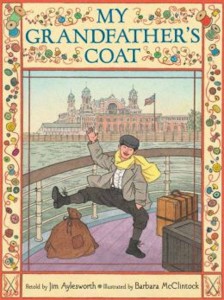By Rita Berman Frischer, Special to The Jewish Sound
A delightfully illustrated retelling of an old story provides us another slant on recycling, a graphic novel sensitively shows a French child her grandmother’s story of how she and her mother survived the Holocaust, and an imaginative take on the Noah story puts a 16-year-old stowaway on the Ark to witness the family’s struggle as they care for the animals to ensure the continuance of life on this earth.
Every year, the Sydney Taylor Book Award committee of the international Association of Jewish Libraries evaluates the latest crop of books for children, looking for those with literary quality that also reflect authentic aspects of Jewish life and experience.
Here are the most recent winners and honor books:
For younger readers (Pre-K–2nd Grade)
In “My Grandfather’s Coat” (Scholastic Press, 2014), author Jim Aylesworth and illustrator Barbara McClintock provide a delightful version of the Yiddish folksong “I Had a Little Overcoat.” Showing a Seattle-like dedication to never wasting a thing, it tells of an immigrant grandfather who became a tailor and made, over the years, a productive life — an American life.
After he celebrates his marriage by making himself a beautiful wedding coat, the illustrations show him recycling this coat into different forms, each marking important moments for his family. Finally, frayed and worn out, its remnants become a nest for mice and its history becomes the story between the covers of this book. In 1999, AJL recognized “Joseph Had a Little Overcoat” by Simms Taback for very young children. This version, however, is enhanced by back pages with comments by both author and illustrator and added a quirky guide to making “Grandfather’s Coat Cookies” on the back of the colorful book jacket.
Honor books: “Goldie Takes a Stand” by Barbara Krasner (Kar-Ben, 2014), illustrated by Kelsey Garrity-Riley; and “Never Say a Mean Word Again: A Tale from Medieval Spain” by Jacqueline Jules, illustrated by Durga Yael Bernhard (Wisdom Tales, 2014). The first describes America-born Golda’s first venture into using her leadership skills for others; the second, based on a Spanish legend, shows how to find the path to cross-cultural understanding if someone takes the first challenging step.
For older readers (3rd–6th grade)
In “Hidden: A Child’s Story of the Holocaust” (First Second, 2014), Loïc Dauvillier and illustrator Marc Lizano use the graphic novel format to show a grandmother hesitantly sharing with her granddaughter what she experienced as a Jewish child hidden in Nazi-occupied France during the Holocaust. With Greg Salsedo’s color work, the illustrations clearly indicate a dark and scary time, but the format and the text make this visual introduction to the Holocaust appropriate for upper elementary and middle grade readers.
 Honor books: Jennifer Elvgren’s “Whispering Town” (Kar-Ben, 2014), illustrated by Fabio Santomauro, shows Danish villagers working out a way to hide a Jewish mother and son until they can safely escape to Sweden. Sadly, Denmark and Jews have become a timely topic, linked by the latest senseless hate-filled attack. In “Death by Toilet Paper” (Delacorte Press for Young Readers, 2014) by Donna Gephart, Benjamin Epstein faces many challenges after his father’s death, mostly financial, even to the threat of being evicted from his home.
Honor books: Jennifer Elvgren’s “Whispering Town” (Kar-Ben, 2014), illustrated by Fabio Santomauro, shows Danish villagers working out a way to hide a Jewish mother and son until they can safely escape to Sweden. Sadly, Denmark and Jews have become a timely topic, linked by the latest senseless hate-filled attack. In “Death by Toilet Paper” (Delacorte Press for Young Readers, 2014) by Donna Gephart, Benjamin Epstein faces many challenges after his father’s death, mostly financial, even to the threat of being evicted from his home.
For teen readers (12 and up)
“Storm” by Donna Jo Napoli (Simon & Schuster Books for Young Readers, 2014) is based on the story of Noah’s Ark, told through the viewpoint of 16-year-old stowaway Sebah. She describes the severe conditions of the flood that took the lives of her family and her own experiences while she shares her observations of the turmoil on the ark between Noah and his family members as well as among the animals.
Honor books: “Isabel’s War” by Lila Perl (Lizzie Skurnick Books), takes a different look at World War II as Isabel, a spoiled American girl, grudgingly resigns herself to sharing her room with a refugee German girl. Along with Isabel, readers will gain much seamlessly integrated factual knowledge, along with heightened curiosity and compassion about the European events that shaped Helga’s past. “Like No Other” by Una LaMarche. (Razor Bill, Penguin Group, 2013) is an unusual, but believable, story told from two viewpoints: One, a Hasidic girl, Devorah, who gets stuck by chance in a hospital elevator during a power outage, with Jaxon, a young African American teen. Unlike her family’s fearful stereotype of black boys, we learn gradually that Jaxon is respectful, close to his family, and dependable. The secretive friendship creates conflict for them both between their individual loyalties to their families and cultures, their mutual attraction, and Devorah’s growing desire for autonomy.